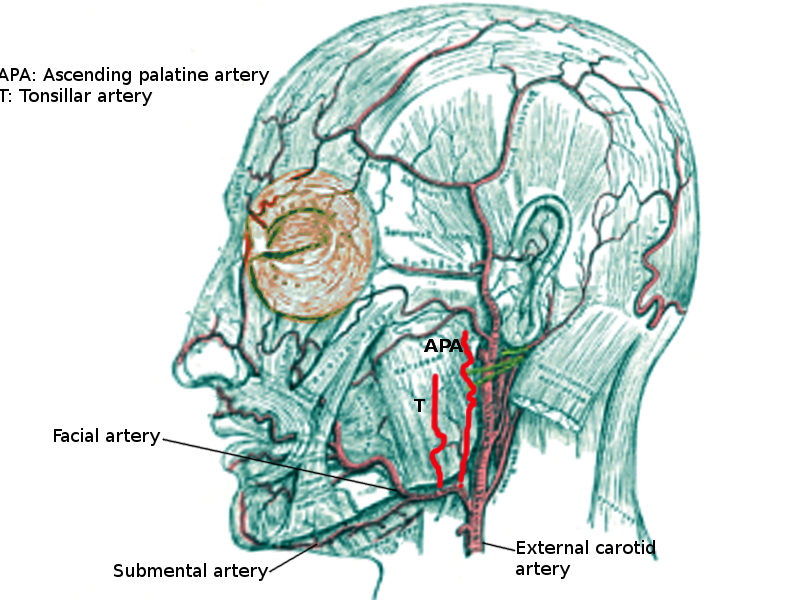[1]
Cho JH, Kim JW, Park HW, Suh JD, Kim JK, Yoon JH. Arterial supply of the human soft palate. Surgical and radiologic anatomy : SRA. 2017 Jul:39(7):731-734. doi: 10.1007/s00276-016-1798-3. Epub 2017 Jan 30
[PubMed PMID: 28138793]
[2]
Huang MH, Lee ST, Rajendran K. Clinical implications of the velopharyngeal blood supply: a fresh cadaveric study. Plastic and reconstructive surgery. 1998 Sep:102(3):655-67
[PubMed PMID: 9727428]
[3]
Meegalla N, Sood G, Nessel TA, Downs BW. Anatomy, Head and Neck: Facial Arteries. StatPearls. 2023 Jan:():
[PubMed PMID: 30725617]
[4]
Katori Y, Kawase T, Cho KH, Abe H, Rodríguez-Vázquez JF, Murakami G, Abe S. Prestyloid compartment of the parapharyngeal space: a histological study using late-stage human fetuses. Surgical and radiologic anatomy : SRA. 2012 Dec:34(10):909-20. doi: 10.1007/s00276-012-0975-2. Epub 2012 May 11
[PubMed PMID: 22576264]
[5]
Suzuki T, Sakashita T, Homma A, Hatakeyama H, Kano S, Mizumachi T, Yoshida D, Fujima N, Onimaru R, Tsuchiya K, Yasuda K, Shirato H, Suzuki F, Fukuda S. Effectiveness of superselective intra-arterial chemoradiotherapy targeting retropharyngeal lymph node metastasis. European archives of oto-rhino-laryngology : official journal of the European Federation of Oto-Rhino-Laryngological Societies (EUFOS) : affiliated with the German Society for Oto-Rhino-Laryngology - Head and Neck Surgery. 2016 Oct:273(10):3331-6. doi: 10.1007/s00405-016-3933-5. Epub 2016 Feb 13
[PubMed PMID: 26874732]
[6]
Cheng NX, Zhang KQ. [The applied anatomic study of palatopharyngeus muscle]. Zhonghua zheng xing wai ke za zhi = Zhonghua zhengxing waike zazhi = Chinese journal of plastic surgery. 2004 Sep:20(5):384-7
[PubMed PMID: 15623114]
[7]
Wang C, Kundaria S, Fernandez-Miranda J, Duvvuri U. A description of arterial variants in the transoral approach to the parapharyngeal space. Clinical anatomy (New York, N.Y.). 2014 Oct:27(7):1016-22. doi: 10.1002/ca.22273. Epub 2014 Feb 7
[PubMed PMID: 24510490]
[8]
Touré G, Moreau A, Ndiaye M, Ory A. Vascularization of the maxilla by a branch of the submandibular artery. Journal of stomatology, oral and maxillofacial surgery. 2019 Sep:120(4):366-368. doi: 10.1016/j.jormas.2019.01.015. Epub 2019 Feb 11
[PubMed PMID: 30763777]
[9]
Bruneder S, Wallner J, Weiglein A, Kmečová Ĺ, Egger J, Pilsl U, Zemann W. Anatomy of the Le Fort I segment: Are arterial variations a potential risk factor for avascular bone necrosis in Le Fort I osteotomies? Journal of cranio-maxillo-facial surgery : official publication of the European Association for Cranio-Maxillo-Facial Surgery. 2018 Aug:46(8):1285-1295. doi: 10.1016/j.jcms.2018.04.023. Epub 2018 May 2
[PubMed PMID: 29805066]
[10]
Cheng N, Zhang K, Song R. [Applied anatomy of arterial supply for the soft palate]. Zhonghua zheng xing wai ke za zhi = Zhonghua zhengxing waike zazhi = Chinese journal of plastic surgery. 2000 Jul:16(4):208-11
[PubMed PMID: 11593673]
[11]
Guziński M, Garcarek J, Kurcz J, Masalski M, Krecicki T. [Endovascular treatment of recurrent hemorrhage after tonsillectomy]. Przeglad lekarski. 2012:69(7):314-6
[PubMed PMID: 23276023]
[12]
Alalawi WA, Almajed E. Unilateral Hard Palate Necrosis After Ascending Palatine Artery Embolization. The Journal of craniofacial surgery. 2018 Jul:29(5):e437-e438. doi: 10.1097/SCS.0000000000004456. Epub
[PubMed PMID: 29521756]

